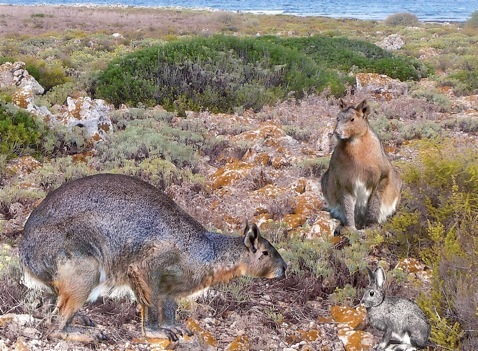
A reconstruction of the king of the rabbits and its more humble cousin. Image: Mieke Köhler
Weighing in at 12 kilograms, the Rabbit King was too big to have enemies.
Researchers have found the fossil of a giant rabbit (Nuralagus rex) at the popular tourist destination of Minorca. The Minorcan “˜King of the Rabbits’ lived approximately three to five million years ago and is estimated to have been six times the weight of its surviving cousin Oryctolagus cuniculus (European rabbit) and ten times that of its extinct mainland cousin (Alilepus sp.).
Dr. Josep Quintana from the Institut de Paleontologia Miquel Crusafont Museum (now Institut Català de Paleontologia) said in the press release “When I found the first bone I was 19 years old, I was not aware what this bone represented. I thought it was a bone of the giant Minorcan turtle!”
The giant rabbit may represent one of the first cases of island rule, which states that big animals on islands become smaller and small animals become bigger. In the case of N. Rex, the lack of mainland predators allowed this bunny to grow to giant size.
The lack of predators also had some other effects- the long springy spine found in the mainland rabbit had been replaced with a shorter stiff spine in N.rex, causing it to lose its ability to hop. “I think that N. rex would be a rather clumsy rabbit walking. Imagine a beaver out of water,” said Quintana.
The rabbit had also lost some of its acute hearing and sight, indicated by the smaller ears and reduced eye socket size. Dr. Brian Kraatz, from the Western University of Health Sciences said in the press release “As evolution has shown repeatedly, strange things happen on islands. Quintana and colleagues dramatically demonstrate that these floppy-eared critters are not as biologically conserved as many of us have thought.”
Researchers have found the fossil of a giant rabbit (Nuralagus rex) at the popular tourist destination of Minorca. The Minorcan “˜King of the Rabbits’ lived approximately three to five million years ago and would have weighed in at 12 kilograms- six times the weight of its surviving cousin Oryctolagus cuniculus (European rabbit) and ten times that of its extinct mainland cousin (Alilepus sp.).
Dr. Josep Quintana from the Institut de Paleontologia Miquel Crusafont Museum (now Institut Català de Paleontologia) said in the press release “When I found the first bone I was 19 years old, I was not aware what this bone represented. I thought it was a bone of the giant Minorcan turtle!”
The giant rabbit may represent one of the first cases of island rule, which states that big animals on islands become smaller and small animals become bigger. In the case of N. Rex, the lack of mainland predators allowed this bunny to grow to giant size.
The lack of predators also had some other effects- the long springy spine found in the mainland rabbit had been replaced with a shorter stiff spine in N.rex, causing it to lose its ability to hop. “I think that N. rex would be a rather clumsy rabbit walking. Imagine a beaver out of water,” said Quintana.
The rabbit had also lost some of its acute hearing and sight, indicated by the smaller ears and reduced eye socket size. Dr. Brian Kraatz, from the Western University of Health Sciences said in the press release “As evolution has shown repeatedly, strange things happen on islands. Quintana and colleagues dramatically demonstrate that these floppy-eared critters are not as biologically conserved as many of us have thought.”
Source: Society of Vertebrate Paleontology






